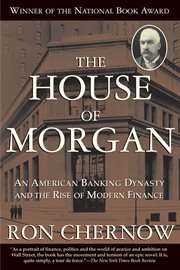Review by Publisher's Weekly Review
J. P. Morgan Sr.'s close relationship with Teddy Roosevelt; his son Jack Morgan's clientele of governments, finance ministers and central banks; and the Morgan realm's split under New Deal legislation are examined in detail in this National Book Award winner. ``Packed with revelations, Chernow's mammoth history demystifies the inner workings of the secretive Morgan banking empire,'' PW said . Photos . Author tour. (Mar.) (c) Copyright PWxyz, LLC. All rights reserved
(c) Copyright PWxyz, LLC. All rights reserved
Review by Library Journal Review
Chernow vividly portrays the influence that the Morgan banks have had on the history of the Western economy since the late 18th century. The epic story of the development of the American industrial experience is inextricably related to the history of the Morgan banks. Though this fascinating story is virtually the same as that told by Kathleen Bunk in Morgan Grenfell 1838-1988 ( LJ 12/89), Chernow adds color and personality with an emphasis on the 20th-century development of the bank. Working with recently discovered Morgan archives, he reveals institutional details long hidden by the protective secrecy of the family. This superb history will be an important book. BOMC, Fortune, and History Book Club featured alternates. --Joseph Barth, U.S. Military Acad. Lib., West Point, N.Y. (c) Copyright 2010. Library Journals LLC, a wholly owned subsidiary of Media Source, Inc. No redistribution permitted.
(c) Copyright Library Journals LLC, a wholly owned subsidiary of Media Source, Inc. No redistribution permitted.
Review by Kirkus Book Review
A brilliant, generation-spanning history of the Morgan banking empire, which offers a wealth of social and political as well as economic perspectives. Whereas most annalists leave off with the 1913 death of John Pierpont, Chernow (a former staff member at the Twentieth Century Fund) delivers a start-to-present chronicle, tracing the Morgan dynasty from the mid-19th century--when founding father Junius Spencer left New England to assume control of a London-based merchant bank--through 1987's traumatic stock-market break. To a significant extent, moreover, the narrative lives up to the subtitle's promise to track the development of latter-day finance. The House of Morgan, Chernow shows, spawned consequential enterprises on both sides of the Atlantic. Over the years, however, legislation (notably, the Glass-Steagall Act), wars, and other factors severed the ties that once bound them. Together or on their own, Morgan firms have been involved in remarkable ventures, escapades, and scandals. To illustrate, Chernow recounts how Pierpont organized major industrial corporations like AT&T, GE, and US Steel, also engineering celebrated ""rescues"" of the US Treasury in 1895 and 1907. His successors financed the Allies during WW I and then survived Wall Street's 1929 Crash. Between the wars, the author reveals, Morgan partners (in addition to more conventional clients) treated with Japanese militarists, Nazi bankers, Mexican dictators, and Italian fascists. With relationships an increasingly less important factor after WW II, Chernow documents how Morgan entities shifted gears to compete for business in an era marked by negotiated commissions, shelf registrations, and violent swings in interest rates. By way of example, he shows how Morgan Stanley, once an above-the-battle investment bank, pioneered hostile takeovers. Its UK counterpart, Morgan Grenfell, followed suit, only to come a cropper in a bid-rigging scheme for Guiness. In the meantime, Morgan Guaranty succumbed to the lure of seemingly easy money from LDC loans and M&A work. Chernow captures and records investment and commercial banking's fitful evolution from a time when institutions relied more on personal character and credit than on collateral to an era of casino capitalism in which tradition plays no part to speak of. He does so in lively, definitive fashion that could make his exhaustively documented account the standard reference for specialists as well as lay readers. The lengthy (771-page) text has over 80 photographs (not seen). Copyright ©Kirkus Reviews, used with permission.
Copyright (c) Kirkus Reviews, used with permission.

